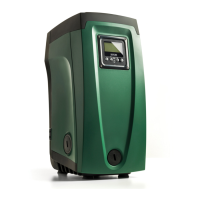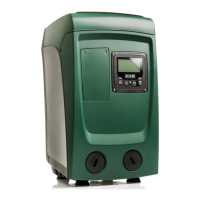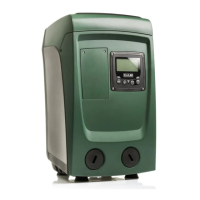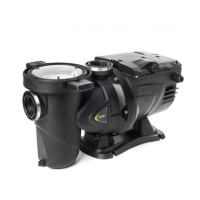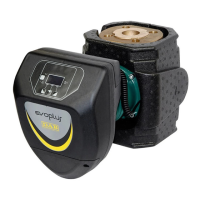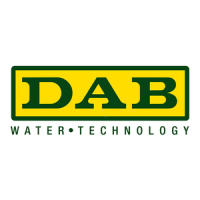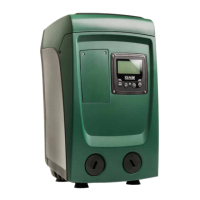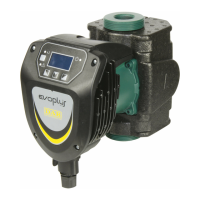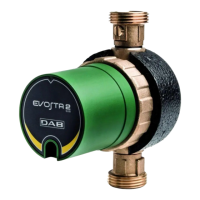ENGLISH
GB
57
INDEX
Key 60
Warnings 60
Responsibility 61
1. General 61
1.1 Description of the Integrated Inverter 62
1.2 Integrated expansion vessel 62
1.3 Integrated electropump 63
1.4 Technical characteristics 64
2. Installation 65
2.1 Vertical Conguration 65
2.1.1 Hydraulic connections 66
2.1.2 Loading operation – Installation above head and below head 67
2.2 Horizontal conguration 67
2.2.1 Hydraulic connections 68
2.2.2 Orientation of the interface panel 68
2.2.3 Loading operation – Installation above head and below head 69
3. Commissioning 69
3.1 Electrical connections 69
3.2 Conguration of the integrated inverter 70
3.3 Priming 70
4. Protection systems 71
4.1 Description of blockages 71
4.1.1 “BL” AAnti Dry-Run (Protection against dry running) 71
4.1.2 Anti-Cycling (Protection against continuous cycles without utility request) 72
4.1.3 Anti-Freeze (Protection against freezing of water in the system) 72
4.1.4 “BP1” Blockage due to fault of the internal pressure sensor 72
4.1.5 PB” Blockage due to line voltage outside specications 72
4.1.6 “SC” Blockage due to short circuit between the motor phases 72
4.2 Manual reset of error conditions 73
4.3 Self-reset of error conditions 73
5. Inverter electronic control and user interface 73
5.1 Operation with control unit 73
5.1.1 Functions made available by control units 74
5.1.2 Electrical connections of utility inputs and outputs 74
5.1.3 Safety mode operation 74
5.1.4 Control unit function setup 75
5.1.5 Association and disassociation of e.sybox and control unit 75
6. The keypad and the display 76
6.1 Direct access with a combination of keys 77
6.2 Access by name with a drop-down menu 80
6.3 Structure of the menu pages 81
6.4 Blocking parameter setting by Password 82
6.5 Enabling and disabling the motor 82
7. Meaning of the individual parameters 82
7.1 User Menu 82
7.1.1 Status 82
7.1.2 RS: Rotation speed display 82
7.1.3 VP: Pressure display 82
7.1.4 VF: Flow display 82
7.1.5 PO: Absorbed power display 83
7.1.6 C1: Phase current display 83
7.1.7 Operating hours and number of starts 83
7.1.8 PI: Power histogram 83
7.1.9 Multi-pump system 83
7.1.10 Output ow meter 83
7.1.11 VE: Version display 83
7.1.12 FF: Fault log display 83
7.2 Monitor Menu 84
7.2.1 CT: Display contrast 84
7.2.2 BK: Display brightness 84
7.2.3 TK: Backlight switch-on time 84
7.2.4 LA: Language 84
7.2.5 TE: Dissipator temperature display 84
7.3 Setpoint Menu 84
7.3.1 SP: Setting the setpoint pressure 84
7.3.2 Setting the auxiliary pressures 84
7.3.2.1 P1: Setting the auxiliary setpoint 1 85
7.3.2.2 P2: Setting the auxiliary setpoint 2 85
7.3.2.3 P3: Setting the auxiliary setpoint 3 85
7.3.2.4 P4: Setting the auxiliary setpoint 4 85
7.4 Manual Menu 85
7.4.1 Status 85
7.4.2 RI: Speed setting 85
7.4.3 VP: Pressure display 86
7.4.4 VF: Flow display 86
7.4.5 PO: Absorbed power display 86
7.4.6 C1: Phase current display 86
7.4.7 RS: Rotation speed display 86
7.4.8 TE: Dissipator temperature display 86
7.5 Installer Menu 86
7.5.1 RP: Setting the pressure fall to restart 86
7.5.2 OD: Type of plant 86
7.5.3 AD: Address conguration 86
